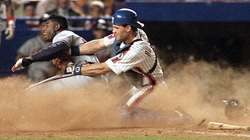
If not for Hundley's injury, the Mets maybe never make the trade for Piazza. In fact, why would the Mets be in the market for another catcher if Hundley was healthy? In 1996, he hit .259, 41, 112 and followed that up with a .273, 30, 86 season a year later. His OPS in 1996 was .906, followed by a .943 OPS in 1997. Add to it the fact that Hundley was about to be 29 in the 1998 season, there would be no reason for the Mets to go out and get another star catcher. Hundley was becoming a star in his own right.
It is hard to imagine the history of the New York Mets franchise without Piazza. Piazza contributed to some of the best moments in the history of the franchise and of course, was on hand closing the door on Shea Stadium. Imagine if Hundley was healthy and Piazza was not needed. In fact, the Mets had toyed with the idea of patching together a catching tandem of Alberto Castillo, Tim Spehr and Rick Wilkins hoping that could get them through the All Star break. That was when Hundley was expected back.
So it was possible that the Mets could have not traded for Piazza even with the Hundley injury. Of course, the rest became history when Piazza was first dealt to the Florida Marlins from the Dodgers in a big trade, then moved to the Mets in a deal that included OF Preston Wilson. By the time Hundley came back, he was without a position, instead being placed in LF which we all remember was a complete disaster. Hundley did not like being out there and eventually he would start behind the plate on Piazza's days off.
After the 1998 season, it became evident Hundley would be dealt. The only thing sitting in the way of that was the status of Piazza, who was a free agent. Had the Mets decided not to sign Piazza, or another team outbid the Mets for his services, the Mets could have conceivably kept Hundley as their catcher going forward. Finally, on December 1, 1998, Hundley was sent to the Los Angeles Dodgers in a deal for OF Roger Cedeno and C Charles Johnson. Of course, Johnson would never have to report to the Mets as he was immediately shipped off to Baltimore in exchange for RHP Armando Benitez.
Hundley had a little bit of a slow start in LA, hitting just .207, but hitting 24 HR for the Dodgers in 1999. He followed it up with a very good 2000 campaign, hitting a career high .284 with 24 HR, 70 RBI and also setting a career high with his .954 OPS. After 2000, he signed as a free agent with the Chicago Cubs, his father's old team, for the next four seasons. His time in Chicago was a nightmare, as he hit just .187, 12, 31 in 2001 and followed that up with a .211, 16, 35 season in 2002. He continuously heard the boos from Wrigley Field and was mercifully dealt back to the Dodgers after the 2002 season. He was just 6-33, 2, 11 in 21 games for the Dodgers, first losing out on the starting catcher's job to Paul LoDuca and then the back-up job to David Ross. Hundley missed the majority of the season (May 3- August 31) due to injury and was relegated to PH duty in September of that season. Afterwards, he would miss the 2004 season- though he managed to make $7 million. He would finish off his career as a .232 hitter with 209 HR, 599 RBI and a .763 OPS in 1225 career games.
Many assume that Hundley took steroids during his career. I guess some can assume that Mike Piazza did too. Call me stupid, but I have never had interest in the accusing players of doing steroids without proof. Rather than call anybody out without proof (since there are no records of confessions, failed drug tests or teammates ratting somebody out), I put the blame on Major League Baseball for not having these tests mandatory earlier. Because of this, I refuse to accuse a player just for the sake of his body mass and season numbers. I just do not have time for that. In conclusion, Todd's father, Randy Hundley, who played for the Cubs (10 seasons), Giants, Twins and Padres over his 14 year career (1964-1977), finished his career as a .236 hitter with 82 HR, 361 RBI and a .642 OPS in 1061 games.


 RSS Feed
RSS Feed
